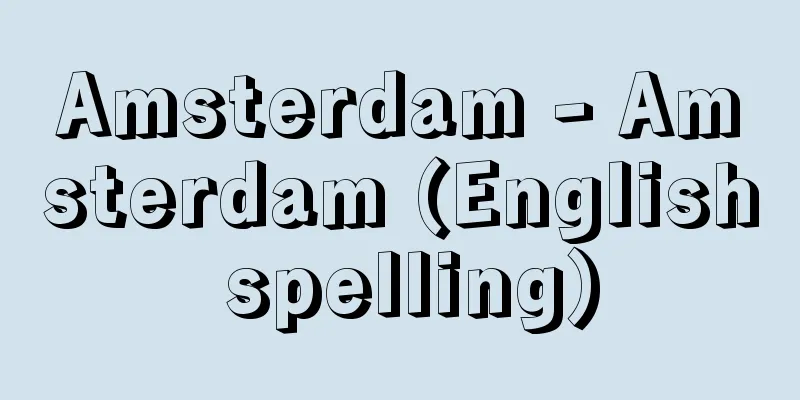Amsterdam - Amsterdam (English spelling)

|
The Hague is the constitutional capital of the Netherlands (the actual capital is the Hague), located in the southern part of the province of Noord-Holland in the west of the Netherlands. It has a population of 734,594 (2001), the largest in the Netherlands. The population of the Amsterdam metropolitan area, including the suburbs, is 1,002,868 (2000). It is located at the point where the Amstel River flows into the IJ Bay on the IJsselmeer, and is the center of commerce, industry, transportation, and culture in the Netherlands. It is connected to the North Sea by the North Sea Canal, to the Rhine by the Amsterdam-Rhine Canal, and to the Wadden Sea by the Noord-Holland Canal, and the port of Amsterdam in the north of the city is the second largest trading port in the Netherlands after Rotterdam. In addition to the world-famous diamond polishing industry, which moved from Antwerp in Belgium in the 16th century, there are also various industries such as petrochemicals, shipbuilding, cement, aircraft, electronics, and clothing. In addition, oil refineries have developed along the North Sea Canal, the steel industry in Ijmuiden, which has the characteristics of an outer port, and the food industry in Zaandam in the northern suburbs, forming a major industrial area. Until the Second World War, the city was bustling with imports and trade of rubber, sugar, coffee, and other products from the Dutch East Indies (Indonesia), and commercial and financial activity is still active today, with the stock market and Dutch banks concentrated here. In terms of culture, Amsterdam is home to the University of Amsterdam, founded in 1632, and the Free University, founded in 1880. There are also many cultural facilities, such as the Rijksmuseum, which has a large collection of 17th century Dutch art, including Rembrandt's "The Night Watch," the Stedelijk Museum, which has a collection of modern paintings, the Van Gogh Museum, the Amsterdam Concertgebouw Orchestra's concert hall, the City University Library, and the Rembrandt House. The old town spreads out in a fan shape around the mouth of the Amstel River, and has a developed circular and radial canal network. Around the central Dam Square, there are the Royal Palace, which was once used as the city hall, and the Nieuwe Kerk, which is in the late Gothic style. In addition, there are many historical buildings in the city, such as the Old Church, built in 1334, the Tower of Tears, the Munttoren, and the Anne Frank House. Urbanization is progressing in the suburbs, and large new towns have been built in the west and south, and the international airport Schiphol is located in the southwestern suburbs. [Takaharu Hasegawa] historyAround the middle of the 13th century, a dam was built at the mouth of the Amstel River to prevent seawater from entering from the IJ Bay, and a small settlement was established there. This is the origin of the place name. In 1275, the inhabitants were granted the privilege of exemption from customs duties in the county by Count Floris V of Holland, and around 1300, the city was granted a city charter and the city of Amsterdam was established. In 1323, a customs office for beer imported from the German port of Hamburg to the Holland region was established in the city, and citizens began sailing to Hamburg. Gradually, the city expanded into maritime transport as a key point on the inland route for trade between the Hanseatic cities and Flanders. In the first half of the 16th century, the city became a major market for grain produced in the Baltic Sea region, and in 1585, when Antwerp, the largest trading port in Western Europe, was occupied by Spanish forces, it followed suit and developed rapidly. In the 17th century, with Baltic Sea trade as its foundation, Amsterdam developed into a global market, developing into trade with Spain, the Mediterranean, Asia, and the New World, and the city-run Amsterdam Commodity Exchange (1611) and the Amsterdam Transfer Bank were established. Industries such as shipbuilding, brewing, printing, sugar refining, tobacco processing, and diamond processing flourished, and the city became a global financial market. The city also became the cultural center of the newly independent Dutch Republic, producing painter Rembrandt, philosopher Spinoza, and literary figures such as Vondel and Hooft, and thus built the Golden Age of Dutch culture. Since the 15th century, the wealthy merchant families who had monopolized the posts of mayor (four people) and city councillors (36 people) and ruled as an aristocratic oligarchy, gained more and more power as trade developed, and reigned as the de facto rulers of the Republic. In the 17th century, the city area was expanded, and three semicircular canals, the Heren, the Keizers, and the Prinsen, and magnificent houses along the canals were built. Prosperity reached its peak in the mid-17th century, when the magnificent City Hall (now the Royal Palace) was built. In 1815, when the Kingdom of the Netherlands was established, Amsterdam became its capital, but after a long period of decline, the city's trade and industry resumed development in the second half of the 18th century with the construction of the North Sea Canal (1876) and the Merwede Canal (1892) and the progress of the Industrial Revolution, and the city began to expand after 1840, and urban planning was carried out in the early 20th century. After World War II, the Amsterdam Rhine Canal was opened, and the north and south city areas on either side of the harbor were connected by the Coen and IJ Tunnels, and a new town was constructed. [Fukuya Kurihara] World Heritage RegistrationThe fortresses and defensive lines that surrounded Amsterdam to defend it were registered as a World Heritage Site by UNESCO (United Nations Educational, Scientific and Cultural Organization) in 1996 as the "Amsterdam Defence Line" (World Cultural Heritage). [Editorial Department] Numerous canals run through the city, which was built on marshes. The photo shows a drawbridge at the confluence of the Amstel River and the Nieuwe Herengracht. Amsterdam, Netherlands ©Shogakukan "> Amstel River and Canals It was built in the 17th century as a Palladian-style city hall. It is currently used as a royal palace. Amsterdam, Netherlands ©Shogakukan "> Royal Palace in Amsterdam A late Gothic church facing Dam Square. Known as the place where the Dutch royal coronation takes place. Amsterdam, Netherlands ©Shogakukan "> New Church Amsterdam One of the historical buildings remaining in the city. Munt means "money", and the name comes from the fact that a coin mint was once located here. The polygonal tower was part of the medieval city gate. Amsterdam, Netherlands ©Shogakukan "> Munttoren The hiding place of Anne Frank's family remains in Amsterdam. It has been preserved as it was in the past with the hope of peace. Amsterdam, Netherlands ©Shogakukan "> Anne Frank House This railway line connects Amsterdam with other European cities, including those in the Netherlands. It opened in 1889. It is well known for its red brick station building. Amsterdam, Netherlands ©Shogakukan "> Amsterdam Central Station Source: Shogakukan Encyclopedia Nipponica About Encyclopedia Nipponica Information | Legend |
|
オランダ西部、ノールト・ホラント州南部にある同国の憲法上の首都(実質上の首都はハーグ)。人口73万4594(2001)で、オランダ最大。また郊外地域を含むアムステルダム大都市圏の人口は100万2868(2000)。アムステル川がアイセル湖のアイ湾に流入する地点に位置し、オランダの商工業、交通、文化の中心地となっている。北海とは北海運河、ライン川とはアムステルダム・ライン運河、またワッデン海とはノールト・ホラント運河によって、それぞれ通じるため、市街北部のアムステルダム港はロッテルダムに次ぐオランダ第二の貿易港となっている。工業も、16世紀にベルギーのアントウェルペン(アントワープ)から移ってきた世界的に有名なダイヤモンド研摩業のほか、石油化学、造船、セメント、航空機、電子、服飾などの諸工業が立地する。また、北海運河沿いでは石油精製、外港的性格をもつアイモイデンIjmuidenでは鉄鋼、北郊のザーンダムZaandamでは食品工業が発達し、一大工業地帯を形成している。第二次世界大戦前までは、オランダ領東インド(インドネシア)からのゴム、砂糖、コーヒーなどの輸入と取引でにぎわい、現在も商業・金融活動が活発で、株式市場、オランダ銀行などが集中している。 文化面では1632年創立のアムステルダム大学と1880年創立の自由大学の所在地であり、また、レンブラントの『夜警』をはじめ17世紀オランダ美術を多数所蔵する国立美術館、近代絵画を収集する市立美術館、そのほかゴッホ美術館、アムステルダム・コンセルトヘボウ管弦楽団のコンサート・ホール、市立大学図書館、レンブラントの家などの文化施設が多い。旧市街はアムステル川河口を中心に扇形に広がり、環状、放射状の運河網が発達している。中心のダム広場の周囲には、かつて市庁舎として使われた王宮や後期ゴシック様式の新教会が並び、このほか市内には1334年建設の旧教会や、涙の塔、ムント塔、アンネ・フランクの家などの歴史的な建物が多い。郊外では都市化が進行し、西部、南部では大規模なニュータウンが建設され、また南西郊外には国際空港のスキポール空港がある。 [長谷川孝治] 歴史13世紀中葉ごろ、アムステル川の河口にダムを築いてアイ湾からの海水の浸入を防ぎ、小集落が成立した。これが地名の由来である。1275年、住民はホラント伯フロリス5世から伯領における関税免除の特権を得、さらに1300年ごろ都市特許状を与えられてアムステルダム市が成立した。1323年、ドイツのハンブルク港からホラント地方へ輸入されるビールの税関が当市に置かれ、市民のハンブルク航行が開始され、しだいにハンザ諸都市とフランドル地方との間の貿易における内陸ルートの要衝として海上輸送に進出した。16世紀前半、市はバルト海地域産穀物の一大市場となり、1585年、西ヨーロッパ最大の貿易港アントウェルペンがスペイン軍に占領されると、その後を継いで一挙に発展した。17世紀にはバルト海貿易を基礎として、スペイン貿易、さらに地中海、アジア、新大陸貿易を展開して世界市場となり、商品取引所(1611)、市立のアムステルダム振替(ふりかえ)銀行が設立され、造船、ビール醸造、印刷、精糖、たばこ加工、ダイヤモンド加工などの工業が栄えるとともに、世界的金融市場になった。 市はまた独立を達成したネーデルラント連邦共和国の文化的中心として、画家レンブラント、哲学者スピノザ、文学者のフォンデルやホーフトらを輩出して、オランダ文化の黄金時代を築いた。15世紀以来、市長(4人)、市参事会員(36人)の職を独占して貴族的寡頭支配を行った富裕な大商人門閥は、貿易の発展とともにますます勢力を張り、共和国の実質的な支配者として君臨した。17世紀に市域は拡大され、半円状のヘーレン、カイゼル、プリンセンの3運河と、運河沿いの壮麗な住宅が建設され、17世紀中葉に繁栄は絶頂に達し、豪壮な市庁舎(現王宮)が建てられた。1815年、ネーデルラント王国成立とともにその首都となったが、長い衰退ののち、18世紀の後半以降、北海運河(1876)、メルウェーデ運河(1892)の建設、産業革命の進行によって、市の貿易、工業の発展が再開され、1840年以後、市域の拡大も始まり、20世紀初頭には都市計画が実施された。第二次世界大戦後アムステルダム・ライン運河が開通し、クーン、アイ両トンネルにより、港を挟む南北両市域が接続され、新市街が建設された。 [栗原福也] 世界遺産の登録アムステルダム防衛のために、周囲を取り囲むように配された要塞とその防塞線が、1996年ユネスコ(国連教育科学文化機関)により「アムステルダムのディフェンス・ライン」として世界遺産の文化遺産に登録された(世界文化遺産)。 [編集部] 沼沢地に建設された市街には数多くの運河が流れる。写真はアムステル川と新ヘーレン運河の合流地点に架かる跳ね橋。オランダ アムステルダム©Shogakukan"> アムステル川と運河 17世紀にパラディオ様式の市庁舎として建てられた。現在は王宮として使用されている。オランダ アムステルダム©Shogakukan"> アムステルダムの王宮 ダム広場に面して建つ、後期ゴシック様式の教会。オランダ王室の戴冠式が行われることで知られる。オランダ アムステルダム©Shogakukan"> アムステルダム新教会 市内に残る歴史的建造物の一つ。ムントとは「貨幣」の意で、呼称はかつてここに貨幣鋳造所が置かれていたことによる。多角形の塔は中世の市門の一部であった。オランダ アムステルダム©Shogakukan"> ムント塔 アムステルダム市内に残るアンネ一家の隠れ家。平和への願いをこめて往時のまま保存されている。オランダ アムステルダム©Shogakukan"> アンネ・フランクの家 オランダ国内をはじめ、ヨーロッパ各都市とアムステルダムとを鉄道で結ぶ。1889年開業。赤れんが造の駅舎でよく知られる。オランダ アムステルダム©Shogakukan"> アムステルダム中央駅 出典 小学館 日本大百科全書(ニッポニカ)日本大百科全書(ニッポニカ)について 情報 | 凡例 |
Recommend
Eugenics - English spelling: eugenics
Applied bioscience that arose with the goal of imp...
Carving board - Eriita
〘 noun 〙 A block on which a picture or calligraphy...
Atriplex gmelinii (English spelling) Atriplex gmelinii
…[Tetsuichi Yahara]. … *Some of the terminology t...
Kotobuki - Kinsho
...There are dongxiao of various lengths, but unl...
Fertilizer industry
An industry that produces organic and chemical fe...
Hirano Shrine
It is located in Hiranomiya Honmachi, Kita Ward, ...
Yarilo
...To pray for the revival of nature and to welco...
Photios - Photios (English spelling)
Patriarch of Constantinople, who was in conflict w...
Mulberry orchard - Souen
A field where mulberry trees are grown for sericu...
Wild Geese - Cancer
A full-length novel by Mori Ogai. It was serializ...
Koto player - This year
〘Noun〙① A person who makes or repairs koto. Also, ...
Whirlybird
...The climbing species is good for fences and he...
Utricularia aurea (English spelling) Utriculariaaurea
…[Katsuhiko Kondo]. … *Some of the terminology th...
Reval
…Population: 482,000 (1991). Formerly known as Re...
Sleeping in a pile - Zakone
A large number of men and women sleeping together ...



![Esco [river] - Esco](/upload/images/67cf9f38d16a1.webp)





